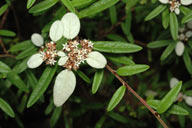In Flower This Week
A weekly news sheet prepared by a Gardens' volunteer.
Numbers before each plant refer to temporary IFTW labels in the gardens.
Numbers in square brackets [ ] refer to garden bed Sections. Plants in flower are in bold type.
View past issues of 'In Flower This Week'.
8 January 2014
Spyridium burragorang click for larger image |
We will walk from the Visitor Information Centre (VIC) along the Main Path today.
- At the door of the VIC is a pot containing Rhododendron viriosum [Section 224] with bright coral bell flowers and shiny green foliage. This is one of the few representatives of the genus in Australia.
- On the other side of the door is Banksia baxteri [Section 221] or Bird’s Nest Banksia, with tall spires of stiff, triangular pink-tipped foliage and green brush flowers.
- Further on your right is Spyridium burragorang [Section 174] whose flower heads consist of a centre of tiny white flowers surrounded by large white bracts.
- On your left is a pot of Grevillea juncifolia [Section 210] with narrow bootlace leaves and long racemes of yellowish-white flowers. This grevillea grows in dry inland Australia.
- Go over the bridge and past the café to see a Syzygium sp. [Section 131] on your left with plenty of fluffy white flowers and neat shiny foliage.
- Go up the hill to see on the left Babingtonia pluriflora [Section 30], a tall shrub with drooping foliage. It is currently covered in small white blooms surrounded by a cloud of beetles.
- Stenocarpus angustifolius [Section 9] on your right has clusters of lemon flowers in attractive contrast to the lance-shaped light green foliage.
- On the right-hand side before you cross the road is Grevillea ‘Coconut Ice’ [Section 25], which has large pink spider flowers with long red styles.
- Crowea exalata [Section 112] is a mounded bush of fine foliage with pink star flowers.
- Go into the Sydney Region Gully to see on your right Teucrium argutum [Section 191i], an upright groundcover with spires of purple flowers.
- On your left is Platysace lanceolata [Section 191e], with white flower heads covering an open bush.
- Also on your left is the Needle Geebung, Persoonia acerosa [Section 191e], with gold spikes of blooms on needle-like foliage.
- Podolobium aciculiferum [Section 18] on your left has golden flowers and sharply-pointed dark green foliage.
- Near the waterfall on your right is Eucalyptus macrocarpa or Mottlecah [Section 15s], with striking grey sword-like foliage and large red fluffy flowers.
- Lythrum salicaria or Purple Loosestrife [Section 15v] has plumes of pink-purple flowers on light green foliage. This plant is widely distributed throughout Europe, Asia and Africa as well as Australia.
- Eremophila christopheri [Section 15v] also on your right has mauve bell flowers on a small bush.
- Babingtonia ‘Howie’s Feathertips’ [Section 110] is a large bush of dense light green foliage with masses of tiny white flowers.
- Turn left at the waterfall down the hill towards the VIC to see on the right Callistemon pachyphyllus ‘Smoked Salmon’ [Section 110] with pink brush flowers on stiff foliage.
- Also on your right is Callistemon brachyandrus [Section 110], which has red flowers with gold tips. Its common name is Prickly Bottlebrush and it lives up to this description!
- Eremophila maculata [Section 302] has bright pink tubular flowers on a small bush.
- Eremophila longifolia [Section 302] is a small tree with long narrow leaves and pink tubular flowers.
- On the left is Eremophila strongylophylla [Section 302] with bright purple bell flowers on grey-green foliage.
Rosalind Walcott
![Director of National Parks [logo]](../../../../images/dnp_90px.gif)







